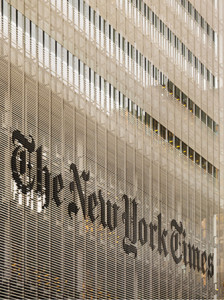 Stiles Says: Maybe the public wouldn’t pay for objective journalism because the journalists stopped being objective and lost their credibility anyway.
Stiles Says: Maybe the public wouldn’t pay for objective journalism because the journalists stopped being objective and lost their credibility anyway.
The Bullets:
*The New York Times will start featuring branded content in January.
*It’s to “restore digital advertising revenue to growth.”
*Branded content will only be in the digital version.
*The newsroom will have no part in creating branded content.
*Branded content will feature a blue border, a mark of “Paid Post,” and a different typeface.
*Branded content is now an integral part of digital publishing.
*The media landscape is changing, but it’d also change if The NYT went belly up.

All of that seems pretty standard at this point, in the fashion, beauty, and lifestyle spaces. But, how would you feel if you started seeing similar branded articles in The New York Times? Publisher Arthur Sulzberger, Jr. announced on Thursday that the paper of record will begin featuring branded content in January 2014. For a publication experiencing shrinking ad revenue and an exodus of editorial staff seeking new digital homes, this decision seems like a logical next step. The decision stems from a desire to “restore digital advertising revenue to growth,” according to Sulzberger.
While the branded content will exist only in the digital version of the publication, it will appear in a variety of formats, including narratives, video, and data visualizations. When done wrong, native advertising can sometimes confuse readers, since it often blends in seamlessly with editorial content. To address this, Sulzberger says there will be a "strict separation between the newsroom and the job of creating content for the new native ads.” In other words, the newsroom will have no part in creating the branded material. And, to make sure readers are clear on the difference between editorial and branded articles, the branded content will feature a blue border, a mark of "Paid Post," and a different typeface. Executive editor Jill Abramson has expressed concerns about native advertising in the past, saying it creates “confusion in readers’ minds about where the content comes from.” But, she's stated that she'll "make sure the Times adheres to the standards” of separation, as outlined by Sulzberger.
This news is certainly a major shift for the Times, but it won't actually be the first time the paper has tried this model of advertising. You may remember, back in June, that it altered its entire home page to promote Brad Pitt's summer blockbuster World War Z. The all-too-real headlines read, "Population Loss Projected at 4.7 Billion" and "43 Cities Have Gone Dark," suggesting the zombie apocalypse had actually arrived. After a few minutes, it became clear that we were seeing an ad for a movie. However, the incorporation of rather plausible news headlines, without any clear denotation that we were seeing branded content, didn't sit well with some readers.
The approach the publication will be taking in January seems to address these concerns. Meaning that the branded content of the future won't feel quite as jarring in the Times.
But, at the heart of the matter, the Times is a publishing company. It needs to run itself as a business. Yes, it provides a tremendous public service in that it reports the news and digs deep to tell the stories that so often find themselves aggregated and quoted across a million other news sites. But, it's still a business, and branded content is an integral part of digital publishing.
Sure, this decision does change the media landscape as we know it. But, you know what? That landscape would also change dramatically if, say, The New York Times ceased to exist.
The full scoop is here
See what else we’ve got @brandcontentst
This entry was posted in Brand Content and tagged brand content, branded content, content marketing, social marketing. Bookmark the permalink.



